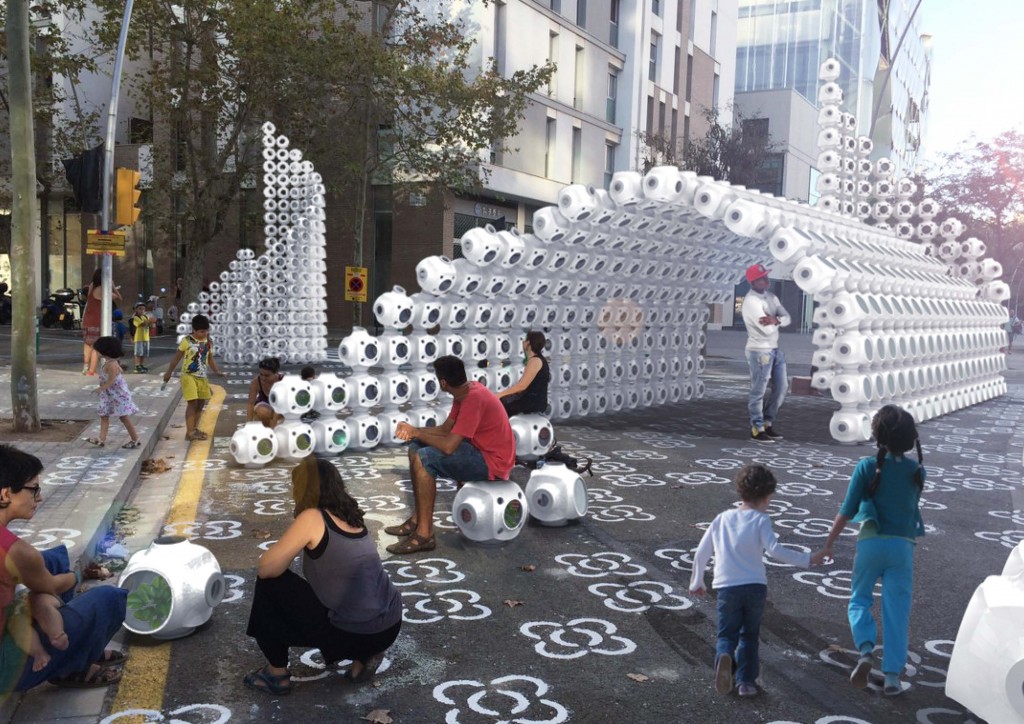The Urban Heat Island Effect is a phenomena that occurs when a concentration of hard surfaces, buildings, cars and people cause an area to increase in temperature when compared to rural areas within the same global region. In some cases, these urban islands can increase up to 1-3 degrees celsius. The goal of our project is to inform the Superblock community within Barcelona about the Urban Heat Island Effect and give them the knowledge and tools to combat it and increase the thermal comfort of their neighborhood. However, we understand the limitations of not only our measuring tools, but our resources as well and will concede that measuring the true effects of the Urban Heat Island requires much more time and a bigger scale. Success with our project can be defined by a more engaged and informed community, creation of small-scale microclimates and a spatial intervention to improve aesthetics.
 If we engage and inform the Superblock community about the Urban Heat Island Effect and the potential of the Superblock itself, then we will change the culture around the Superblock and ideally combat the Urban Heat Island Effect on a larger scale. Our problem is that the general public seems to be ill-informed about the effects of living with an urban setting and they don’t realize the potential of the Superblock to help with this issue. Our immediate scope is to inform and engage the Superblock community and in the future our project aims to combat the Urban Heat Island Effect. We will achieve these goals through experimentation with greenery and transpiration and creating our prototype for our spatial intervention within the Superblock. Ultimately our project will not solve the Urban Heat Island Effect immediately, we need to have people realize the potential of the Superblock as a combative measure against urban heat. We will reduce hard spaces, there will be a reduction of concentrated CO2 emissions, more shade, efficient plant production and transpirational evaporative cooling. The results of our research can be generalized to the extent that with this information, every city can combat the Urban Heat Island Effect. We will specifically be impacting Barcelona by changing the opinion and culture around the Superblock and giving the community the tools to combat urban heat.
If we engage and inform the Superblock community about the Urban Heat Island Effect and the potential of the Superblock itself, then we will change the culture around the Superblock and ideally combat the Urban Heat Island Effect on a larger scale. Our problem is that the general public seems to be ill-informed about the effects of living with an urban setting and they don’t realize the potential of the Superblock to help with this issue. Our immediate scope is to inform and engage the Superblock community and in the future our project aims to combat the Urban Heat Island Effect. We will achieve these goals through experimentation with greenery and transpiration and creating our prototype for our spatial intervention within the Superblock. Ultimately our project will not solve the Urban Heat Island Effect immediately, we need to have people realize the potential of the Superblock as a combative measure against urban heat. We will reduce hard spaces, there will be a reduction of concentrated CO2 emissions, more shade, efficient plant production and transpirational evaporative cooling. The results of our research can be generalized to the extent that with this information, every city can combat the Urban Heat Island Effect. We will specifically be impacting Barcelona by changing the opinion and culture around the Superblock and giving the community the tools to combat urban heat.
Our modules’ design draws from the strenghts of humidifiers and terrariums to humidify the air in an efficient manner with the aid of transpiration. Our system should lose little water to evaporation and maximize plant growth with a hydroponic watering system.
Our project was given further direction by aiming to improve upon the publically stated goals of the Superilla. Conceptually, the Superilla was implemented to 1) increase sustainable mobility, 2) revitalize public space, 3) promote biodiversity and urban green, and 4) integrate the governance processes. Thus, are project has ambitions environmentally, spatially, and socially.
Modular Micro-Climates is a project by the Institute for advanced architecture of Catalonia, developed in the CIEE Global Architecture & Design Spring 2017 program by:
Students: Ian Curtis, Curran Moore, Matt Goodwin, Connor Church
Faculty: Mathilde Marengo
Faculty Assistant: Maria Kuptsova
Teaching Assistant: Iacopo Neri
Fabrication Seminar Faculty: Rodrigo Aguirre
Data Seminar Faculty: Marco Sanalitro